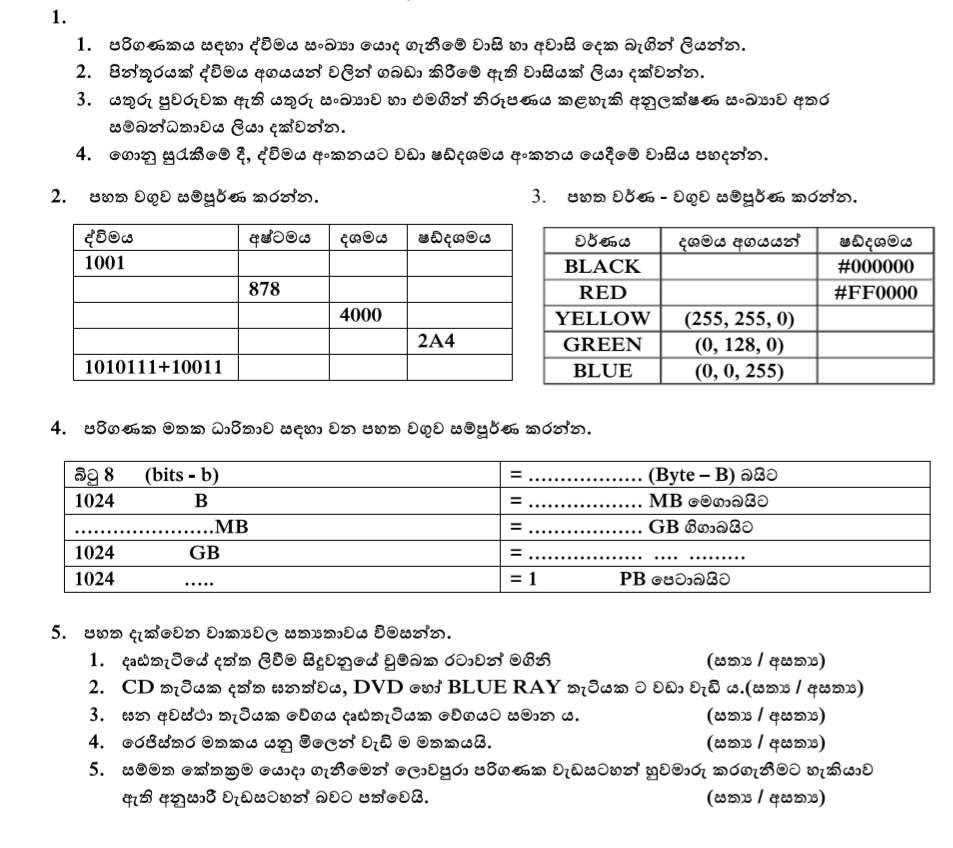Give correct answers to the questions asked You have the option to provide relevant answers on a sheet and insert them as an image

- Advantages of using binary for computers:
- Simplicity: Binary uses only two symbols (0 and 1), making it easy for electronic circuits to represent and process data. This simplicity facilitates the design and construction of computer hardware.
- Reliability: Binary systems are less prone to errors because they have clear distinctions between two states (0 and 1). This robustness is crucial in critical computing applications.
- Compact representation: Binary numbers require fewer digits to represent the same value as decimal numbers, making storage and data transmission more efficient.
- Logical operations: Binary is well-suited for logical operations, such as AND, OR, and NOT, which form the basis for computer arithmetic and decision-making.
- Compatibility: Most computer hardware and software are designed to work with binary data, making it a universal language for computing devices.
Disadvantages of using binary for computers:
- Human readability: Binary representation is not intuitive for humans, making it challenging to understand and work with directly. This complexity can lead to mistakes during manual data manipulation.
- Larger representations: Binary numbers typically require more digits to represent the same value as decimal numbers, resulting in larger numbers for the same quantity.
- Mental effort: Converting between binary and decimal can be mentally taxing for humans, especially when dealing with large numbers.
- Limited precision: Floating-point arithmetic in binary can lead to precision errors, which may affect the accuracy of certain calculations.
- Limited human interaction: Binary representation is not user-friendly, and most people find it difficult to interact with computers using only binary code.
2. Storing images in binary format offers several advantages, which are as follows:
- Efficiency: Binary representation of images is highly efficient in terms of storage space. Images are typically composed of pixels, and each pixel’s color or intensity can be represented with a binary number. This compact representation enables images to be stored and transmitted more efficiently.
- Speed: Binary images can be processed quickly by computer hardware and software. Since modern computer architectures are designed to work with binary data, operations on binary images can be performed efficiently, making image processing tasks faster.
- Compression: Binary images can be easily compressed using various algorithms, reducing their size while preserving essential visual information. Compression techniques like run-length encoding or Huffman coding are well-suited for binary image data.
- Compatibility: Binary image formats are widely supported across different computing platforms and software applications. This compatibility ensures that images can be easily exchanged and displayed on various devices without any loss of information.
- Lossless storage: Binary storage allows for lossless representation of images, meaning there is no loss of image quality during storage. This is particularly important when images need to be preserved without degradation, such as in archival or scientific applications.
- Easy manipulation: Binary images lend themselves well to various image processing operations, such as filtering, morphological operations, and edge detection. These operations are efficiently performed on binary representations, enabling easy manipulation of images for analysis and enhancement.
- Binary logic operations: Binary images can be combined using logical operations (AND, OR, XOR) to create new images. This capability is valuable in applications like computer graphics, computer vision, and digital art.
- Bit-level access: Storing images in binary format allows direct bit-level access to the image data, which can be beneficial in certain specialized applications and low-level image processing tasks.
Overall, storing images in binary format provides numerous advantages in terms of efficiency, speed, compatibility, and versatility, making it the standard choice for representing and working with images in the digital domain.
3. Advantages of hexadecimal at storing data:
- Compact representation: Hexadecimal uses base-16, which means it can represent larger numbers using fewer digits compared to binary. This makes it more concise and easier for humans to read and write.
- Human readability: Hexadecimal symbols (0-9 and A-F) are more intuitive for humans to interpret and work with compared to binary (0 and 1). Hexadecimal provides a good compromise between binary’s low-level representation and decimal’s readability.
- Memory addressing: In computer memory, hexadecimal is often used for memory addresses. Memory addresses are usually represented in hexadecimal to facilitate debugging and low-level programming tasks.
- Color representation: Hexadecimal is commonly used to represent colors in web design and image processing applications. Each color channel (Red, Green, and Blue) can be expressed using two hexadecimal digits, providing a straightforward and compact representation.
Advantages of binary for storing data:
- Efficient hardware representation: Binary is the native language of computers, and most computer hardware is designed to work directly with binary data. Storing data in binary aligns perfectly with the underlying electronic circuitry, making it more efficient for computer systems.
- Simplicity: Binary uses only two symbols (0 and 1), making it straightforward for electronic circuits to represent and process data. This simplicity is essential in low-level hardware design and digital logic operations.
- Error detection and correction: In certain applications, binary data is advantageous for error detection and correction algorithms. Techniques like parity checks and cyclic redundancy checks are commonly used in binary data transmission to ensure data integrity.
- Logical operations: Binary is well-suited for logical operations like AND, OR, and XOR, which forms the basis for computer arithmetic and decision-making. These operations are fundamental to computer processing.
In summary, hexadecimal is advantageous when human readability and compactness are important, such as in-memory addressing and color representation. On the other hand, binary excels in efficiency and hardware representation, making it the natural choice for computer systems and low-level operations. The choice between hexadecimal and binary storage depends on the specific context and requirements of the application.
